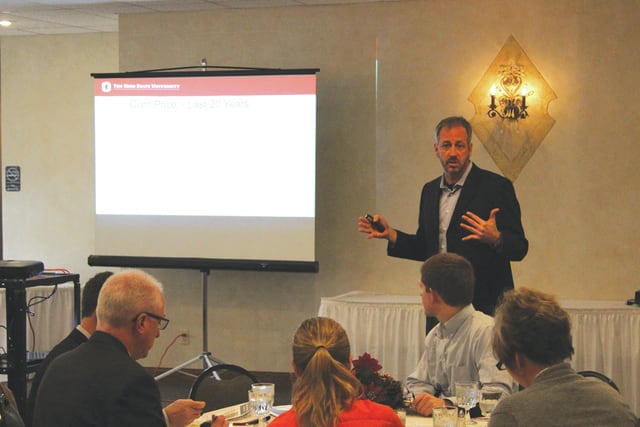
GREENVILLE — Agriculture producers turned out to hear what’s on the horizon as the Ohio State University Extension Offices of Auglaize, Darke, Mercer, Miami, and Shelby Counties hosted a 2107 Ag Outlook Meeting at Romer’s Catering in Greenville recently.
Darke County Commissioner Matt Aultman welcomed the attendees, pointing out the importance of agriculture to Darke County.
“Our county has been the shining gem when it comes to agriculture in the state of Ohio,” he said. “Agriculture is the number one business for our county, it’s the number one employer when counted as a sector of business, and employs one out of every four jobs in the county in one form or another.”
One featured speaker at the event was Barry Ward, assistant professor at the Ohio State University Extension, who gave an overview of land values, cash rents, input costs and crop profitability as it looks for 2017. The outlook for agricultural producers in 2017 will be challenging, he said.
Ward explained that grain prices have seen a decrease over the past few years after a period of high prices from 2010 to 2014, and the decrease has been coupled with rising production costs, particularly in fertilizer and seed.
“After 2006, we started to see some real ramp-ups in prices, and effectively those price points are right there where they were during that high margin period,” he said. “And producers are trying to manage the situation right now, to get through this rough patch where we see some reversion to the mean with some of these costs.”
“At some point, cost structure has to realign with commodity prices where they are,” he added.
Not all is doom and gloom according to Ward, particularly as it regards fertilizer retail prices, which, in Ohio, have fallen anywhere from 17 to 26 percent.
“This is the one bright spot,” he said. “Fertilizer prices have taken a step down since last year.”
However there will be other factors to consider, as Ward pointed out the Energy Information Administration is predicting higher energy costs in 2017.
“The supply/demand fundamentals are showing slight increases in energy costs, and this impacts all of us,” he said, pointing out that crude oil, diesel, natural gas, and gasoline are all expected to rise in cost.
Ultimately, Ward calls the 2017 outlook a “mixed bag” as far as input costs are concerned.
“There’s some good and bad points here as far as what we expect in 2017,” he said. Ward proposed that farmers will see flat to modestly higher energy costs, lower fertilizer costs, flat to modestly lower seed costs, higher depreciation costs for farm machinery and equipment, and modestly lower to modestly higher costs for chemicals, depending on the product.
Dale Ricker, swine specialist at OSU Extension, provided an update on Ohio swine production and its prospects for 2017. While Ohio shows a post-World War II record number of swine (2.7 million) at the end of 2016, the price per head may show a decline in 2017, but this is dependent on a number of factors.
“When we have record numbers on inventory we exceed demand for the product, thus lower prices from packers,” he said, pointing out that Chris Hurt, Ag Economist from Purdue University, is predicting there could be an average loss of $17 per head, following a decline of $10 per head in 2016, based on his studies in the fall of 2016.
“When looking at futures prices for feed ingredients and hog prices for 2017 now, there are many months that can be profitable, which wasn’t the case when Dr. Hurt made his assumptions,” Ricker said. “Another thing to remember is that hog operations can have no debt or a lot of debt, different efficiencies and will impact their cost of production and potential for profit or loss. So to say all producers will lose or make money in 2017 is not correct.”
Regardless, Ricker is optimistic on Ohio’s swine producers heading into 2017.
“Ultimately I feel pretty good about hog production in Ohio as long as producers make good marketing decisions and we can maintain or increase our exports of pork products,” he said.
Other featured speakers at the gathering were David Marrison, Ashtabula County Ag and Natural Resources educator, who spoke on farm and estate tax laws; and Dr. Carl Zulauf, OSU professor Emeritus, who discussed speculation on President Trump’s policy agenda for 2017.


